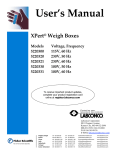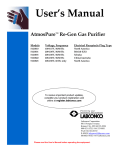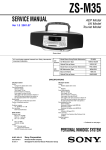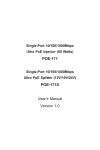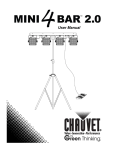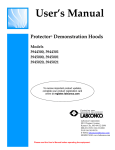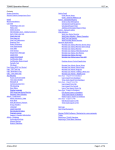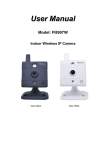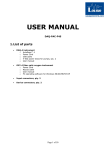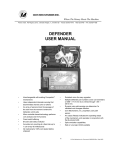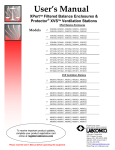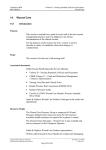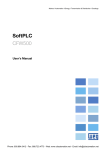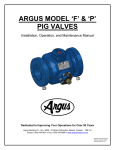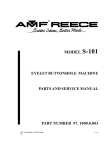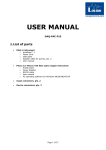Download Precise Controlled Atmosphere and Basic Glove Boxes User`s Manual
Transcript
User’s Manual Precise® Controlled Atmosphere Glove Boxes and Precise® Basic Glove Boxes CA Models 5220100 5220120 5220121 5220130 5220131 Voltage, Frequency 115V, 60 Hz 230V, 50 Hz 230V, 60 Hz 100V, 50 Hz 100V, 60 Hz Basic Models 5220000 5220020 5220021 5220030 5220031 Voltage, Frequency 115V, 60 Hz 230V, 50 Hz 230V, 60 Hz 100V, 50 Hz 100V, 60 Hz To receive important product updates, complete your product registration card online at register.labconco.com Labconco Corporation 8811 Prospect Avenue Kansas City, MO 64132-2696 800-821-5525, 816-333-8811 FAX 816-363-0130 E-MAIL [email protected] HOME PAGE www.labconco.com Please read the User’s Manual before operating the equipment. Copyright © 2007, 2008 Labconco Corporation. All rights reserved. The information contained in this manual and the accompanying products are copyrighted and all rights reserved by Labconco Corporation. Labconco Corporation reserves the right to make periodic design changes without obligation to notify any person or entity of such change. Warranty Labconco provides a warranty on all parts and factory workmanship. The warranty includes areas of defective material and workmanship, provided such defect results from normal and proper use of the equipment. The warranty for all Labconco products will expire one year from date of installation or two years from date of shipment from Labconco, whichever is sooner, except the following; • Purifier® Delta® Series Biological Safety Cabinets and PuriCare® Lab Animal Research Stations carry a three-year warranty from date of installation or four years from date of shipment from Labconco, whichever is sooner. • SteamScrubber® & FlaskScrubber® Glassware Washers carry a two-year warranty from date of installation or three years from date of shipment from Labconco, whichever is sooner. • Blood Drawing Chairs carry a ten year warranty. • Carts carry a lifetime warranty. • Glassware is not warranted from breakage when dropped or mishandled. This limited warranty covers parts and labor, but not transportation and insurance charges. In the event of a warranty claim, contact Labconco Corporation or the dealer who sold you the product. If the cause is determined to be a manufacturing fault, the dealer or Labconco Corporation will repair or replace all defective parts to restore the unit to operation. Under no circumstances shall Labconco Corporation be liable for indirect, consequential, or special damages of any kind. This statement may be altered by a specific published amendment. No individual has authorization to alter the provisions of this warranty policy or its amendments. Lamps and filters are not covered by this warranty. Damage due to corrosion or accidental breakage is not covered. Returned or Damaged Goods Do not return goods without the prior authorization from Labconco. Unauthorized returns will not be accepted. If your shipment was damaged in transit, you must file a claim directly with the freight carrier. Labconco Corporation and its dealers are not responsible for shipping damages. The United States Interstate Commerce Commission rules require that claims be filed with the delivery carrier within fifteen (15) days of delivery. Limitation of Liability The disposal and/or emission of substances used in connection with this equipment may be governed by various federal, state, or local regulations. All users of this equipment are required to become familiar with any regulations that apply in the user’s area concerning the dumping of waste materials in or upon water, land, or air and to comply with such regulations. Labconco Corporation is held harmless with respect to user’s compliance with such regulations. Contacting Labconco Corporation If you have questions that are not addressed in this manual, or if you need technical assistance, contact Labconco’s Customer Service Department or Labconco’s Product Service Department at 1-800-8215525 or 1-816-333-8811, between the hours of 7:00 a.m. and 6:00 p.m., Central Standard Time. Part #5233701, Rev. A ECO E766 TABLE OF CONTENTS CHAPTER 1: INTRODUCTION 1 CHAPTER 2: PREREQUISITES Support, Vibration & Preventive Requirements Location Requirements Exhaust Requirements for the Pressure Relief Valve Electrical Requirements Plumbing Requirements for Gas, Vacuum, & Drying Train Space Requirements 2 3 3 3 4 4 5 CHAPTER 3: GETTING STARTED Unpacking the Glove Box Installing the Glove Box on a Supporting Structure & Work Surface Connecting the Exhaust to the Pressure Relief Valve Installation of Gloves to the Glove Ports Connecting the Electrical Supply Source Connect the Plumbing Lines for Gas, Vacuum & Drying Train Validating the Glove Box Oxygen Method Leak Testing Summary (ISO 10648-2) Pressure Change Method Leak Testing Summary (ISO 10648-2) 6 7 7 8 13 13 14 20 22 23 CHAPTER 4: PERFORMANCE FEATURES AND SAFETY PRECAUTIONS Performance Features Safety Precautions 24 24 27 CHAPTER 5: USING YOUR GLOVE BOX Routine Daily Work Procedures Hazardous Use with Chemicals Prohibited Acid Use 29 29 31 31 CHAPTER 6: MAINTAINING YOUR GLOVE BOX Routine Maintenance Schedule Initial Certification Recertification Fluorescent Light Replacement Pressure Relief Valve Replacement Service Valve and Pressure Gauge Replacement 32 32 33 33 33 33 34 CHAPTER 7: ACCESSORIZING YOUR GLOVE BOX 35 CHAPTER 8: ELECTRICAL SYSTEM TROUBLESHOOTING 42 APPENDIX A: REPLACEMENT PARTS 43 APPENDIX B: DIMENSIONS 45 APPENDIX C: SPECIFICATIONS 46 APPENDIX D: PRECISE CONTROLLED ATMOSPHERE PURGE & FILL REDUCTION RATES 47 APPENDIX E: LIFE SPAN FOR OXYGEN REMOVAL COLUMN & MOISTURE TRAP REMOVAL 49 APPENDIX F: IONIZER FAN PERFORMANCE CRITERIA 51 APPENDIX G: HELIUM LEAK TEST METHOD 53 APPENDIX H: PLUMBING DIAMGRAMS 55 APPENDIX I: PRESSURE & FLOW RATE CONVERSIONS 57 APPENDIX J: REFERENCES 58 DECLARATION OF CONFORMITY 59 Chapter 1: Introduction Congratulations on your purchase of a Labconco Precise® Controlled Atmosphere Glove Box or Precise® Basic Glove Box manufactured with a one-piece molded polyethylene liner. The Precise Controlled Atmosphere Glove Box comes equipped with six valves, pressure relief valve and two chamber pressure gauge indicators, which are omitted from the Precise Basic Glove Box. The Precise Basic Glove Box allows the end user to customize the glove box to their application needs or use the glove box in its simplest form. Both glove boxes are designed to provide an effective physical barrier between the laboratory and the glove box interior. The barrier provides three distinct advantages. First, it helps protect the technician from hazardous materials. Second, it protects materials and laboratory equipment inside the main chamber from the effects of exposure to ambient air, oxygen, and moisture levels. Third, it provides a protective, leak-tight environment for your research, testing, or production procedures; the leak rate of the glove box is rated Class 1 for controlled atmosphere chambers per ISO 10648-2 test methods. Each Precise Controlled Atmosphere Glove Box or Precise Basic Glove Box is helium leak tested at the factory to ensure no leaks greater than 1 x 10-4 cc/sec. The Precise Glove Boxes offer many unique features to enhance performance. To take full advantage of them, you must read and understand this manual and keep it handy for future reference. If you are unfamiliar with how the Precise Glove Boxes operate, please review Chapter 4: Performance Features and Safety Precautions before you begin working in the glove box. Even if you are an experienced user, please review Chapter 5: Using Your Glove Box so you can use the glove box efficiently. Product Service 1-800-522-7658 1 Chapter 2: Prerequisites Before you install the glove box, you need to prepare your site for installation. You must be certain that the area is level and of solid construction. In addition, a dedicated source of electrical power should be located near the installation site to power the glove box. Additionally, the glove box should be strategically placed in the lab to provide efficient workflow and prevent operator interference from normal traffic flow. Carefully read this chapter to learn the requirements for your installation site: • The support, vibration and preventive requirements. • The location requirements. • The exhaust requirements for the pressure relief valve. • The electrical power requirements. • The plumbing requirements for gas, vacuum, and dry train. • The space requirements. Refer to Appendix B: Precise Glove Box Dimensions for complete glove box dimensions. Refer to Appendix C: Precise Glove Box Specifications for complete electrical and environmental conditions, specifications and requirements. 2 Product Service 1-800-522-7658 Chapter 2: Prerequisites Support, Vibration and Preventive Requirements In the preparation of a glove box site, please consider the following: • A bench or stand that is rigidly mounted to the floor or fixed to the wall, but not both, may be appropriate. 35" to 40" (889mm to 1,016mm) is typical for standing height (Labconco stands offered in Chapter 7 vary from 33" to 40" or 838mm to 1,016mm). • The corners of a building typically have less vibration than the center, which promotes analytical balance stability. • The bench typically should not contain any vibration-producing equipment, such as shakers or pumps. • A marble slab with dampening pads placed within the enclosure is an effective low cost means of controlling vibration for analytical balance operation (see Chapter 7: Accessorizing Your Glove Box). Location Requirements The Precise Glove Boxes have been designed to rest on a typical 29"-30" (737mm-762mm) deep work surface. The height should be 35"-40" for standing position. Avoid placing the glove box in high traffic areas where walking might disrupt the operator or experimentation. Exhaust Requirements for the Pressure Relief Valve To prevent over or under pressurization of the main glove box chamber, the Precise Controlled Atmosphere Glove Box includes a pressure relief valve that activates at pressures and vacuums above +6" water gauge or below -6" water gauge. ! WARNING: The overpressurization of air at positive pressure would allow any contaminants inside the glove box to vent into the room. To control this venting into the laboratory, Labconco offers three pressure relief valve ventilation accessories. All three of these pressure relief valve ventilation accessories are shown in detail in Chapter 3 and can be ordered from Chapter 7. Please see Chapter 7 to order the pressure relief valve and other valve accessories for the Precise Basic Glove Box. Product Service 1-800-522-7658 3 Chapter 2: Prerequisites The first option for venting the pressure relief valve is for ducting unfiltered air to the outside via a 4" nominal diameter exhaust duct. The second and third options for venting the pressure relief valve will add HEPA filters and/or carbon filters to the exhaust duct and allow the vented air back into the laboratory or to the outside. The HEPA filtered and carbon filtered pressure relief vent kits may be combined if so desired. All pressure relief valve vent kits include a 4" diameter thimble duct connection to aid in the connection to the building exhaust blower preventing the pressure relief valve from activating due to the negative pressure of the building exhaust. Labconco offers accessory remote blowers listed in Chapter 7 for your convenience in venting the pressure relief to the outside. These blowers have a 6" diameter nominal inlet and a 4" x 6" duct transition is necessary to adapt from the 4" diameter thimble connection provided with all relief valve kits. ! WARNING: In the case of failure caused by excessive vacuum within the main chamber, the user must safely determine whether laboratory atmosphere entering the glove box could result in fire, explosive hazard or damage to property inside the glove box. See Figures 3-1, 3-2, and 3-3 in Chapter 3 for ventilation connection diagrams of the vent kits. Electrical Requirements Electrical receptacles should be located nearby for connecting the glove box, or other optional laboratory equipment. The entire glove box is rated 115V, 8A or 230V, 4A or 100V, 8A. One duplex outlet is located inside the glove box and is rated for 115V, 5A or 230V, 2A or 100V, 5A. Additional power strip accessories are available and can be connected to the interior duplex outlet (see Chapter 7). Plumbing Requirements for Gas, Vacuum, and Drying Train The Precise Controlled Atmosphere Glove Box has four valves located on the main glove box chamber and two valves located on the transfer chamber. Two of the four valves on the main chamber should be used for the operation of the main chamber gas inlet and vacuum outlet lines. To prevent overpressurization, the gas inlet lines should be set at a pressure of 10-30 psi through the use of a gas supply pressure regulator. The other two valves on the main chamber can be used for connections to a recirculating drying train. Drying trains are recirculating contaminate removal traps, powered by vacuum pumps. They are used for the removal of oxygen and/or moisture from the main chamber atmosphere. They can also be used to remove organic vapors, acids, ammonia, or radioisotopes. See Chapter 7 for ordering 4 Product Service 1-800-522-7658 Chapter 2: Prerequisites optional drying train removal traps. The two valves on the transfer chamber are used for gas inlet and vacuum outlet lines. The transfer chamber lines can be connected together with the main chamber gas inlet and vacuum outlet lines to simplify gas and vacuum connections to both chambers. Illustrations for all gas, vacuum, and recirculating drying trains are shown in Figures 3-5 through 3-10 in Chapter 3. All valves utilize 3/8" (9.5mm) compression fittings or 3/8" (9.5mm) hose barbs for soft tubing. Both styles are offered for your convenience. Accessory gas and vacuum tubing kits are described in Chapter 7. Should you require automatic chamber pressure controls, see Chapter 3 for details on the accessory Pressure Controller and Chapter 7 for ordering information. The Pressure Controller automatically monitors and controls pressures in both the main chamber and transfer chamber; it also automates the operation of purging and filling each chamber (gas outlet and gas inlet) up to 199 cycles. Consult your Safety Officer should you require ventilation and/or filtration of the vacuum pump exhaust. Filtered exhaust (0.2 micron) and contaminate removal traps are available for the vacuum pump (see Chapter 7). See Chapter 3 for typical installation of vacuum outlet and inert gas inlet lines and Appendix H for plumbing diagrams. See Chapter 7 to order any valves and/or pressure/vacuum gauges for the Precise Basic Glove Box as these features have been omitted to enable the end user customization. Space Requirements The dimensions are shown in Appendix B: Dimensions. Adequate space to the right of the transfer chamber is required for loading and unloading. Product Service 1-800-522-7658 5 Chapter 3: Getting Started Once the site for your glove box is properly prepared, you are ready to unpack, inspect, install, and validate performance of your system. Read this chapter to learn how to: • Unpack and move the glove box. • Set up the glove box with the proper supporting structure and work surface. • Connect an exhaust system to the pressure relief valve (if applicable). • Install the gloves. • Connect the electrical supply. • Connect the plumbing lines for gas, vacuum, and drying train. • Validate performance of the glove box. ! 6 Each Precise Glove Box model weighs 185 lbs. each (83 kg). The shipping container allows for lifting with a mechanical lift truck or floor jack. If you must lift the glove box manually, follow safe-lifting guidelines. Do not lift by the upper sheet metal façade and front panel as damage can occur to the glove box liner. Product Service 1-800-522-7658 Chapter 3: Getting Started Lifting Instructions Unpacking the Glove Box We recommend that you do not remove the glove box from its shipping container until it is ready to be placed into its final location. Move the unit by placing a flat, low dolly under the shipping skid, or by using a floor jack. Carefully remove the shrink-wrap and carton on the glove box and inspect it for damage that may have occurred in transit. If damaged, notify the delivery carrier immediately and retain the entire shipment intact for inspection by the carrier. ) THE UNITED STATES INTERSTATE COMMERCE COMMISSION RULES REQUIRE THAT CLAIMS BE FILED WITH THE DELIVERY CARRIER WITHIN FIFTEEN (15) DAYS OF DELIVERY. ) DO NOT RETURN GOODS WITHOUT THE PRIOR AUTHORIZATION OF LABCONCO. UNAUTHORIZED RETURNS WILL NOT BE ACCEPTED. Product Service 1-800-522-7658 7 Chapter 3: Getting Started ) IF ENCLOSURE WAS DAMAGED IN TRANSIT, YOU MUST FILE A CLAIM DIRECTLY WITH THE FREIGHT CARRIER. LABCONCO CORPORATION AND ITS DEALERS ARE NOT RESPONSIBLE FOR SHIPPING DAMAGES. Do not discard the packing material until you have checked all of the components and tested the glove box. Installing the Glove Box on a Supporting Structure and Work Surface Exercise caution when lifting or moving the glove box. When installing the glove box onto a work surface or benchtop, ensure that the structure can safely support the combined weight of the glove box and any related equipment. The work surface should be as wide as the entire glove box to properly support it. The front of the glove box should be aligned with the front of the work surface for optimal comfort. A height of 35"-40" (889mm-1016mm) is appropriate for standing operation. Labconco base stands from Chapter 7 may be adjusted in height from 33"-40" (838mm1016mm). Connecting the Exhaust to the Pressure Relief Valve (If Applicable) ! WARNING: The weight of the pressure relief exhaust ductwork system must be supported independently of the glove box superstructure or damage may occur. The exhaust system should be installed by a qualified HVAC contractor. As stated in Chapter 2, the main chamber pressure relief valve is exhausted back into the room unless an optional vent kit is installed. Figure B-1 in Appendix B shows the location of the pressure relief valve without any optional vent kits. Labconco provides pressure relief exhaust kits, which exhaust to the outside. HEPA and/or carbon filtered exhaust kits are also available. The HEPA and/or carbon filtered pressure relief exhaust kits also provide thimble duct connections for exhausting the pressure relief valve to the outside. 8 Product Service 1-800-522-7658 Chapter 3: Getting Started To connect the Pressure Relief Vent Valve to an exterior exhaust system, order the Ventilation Kit (#5242700) and refer to Figure 3-1. To provide HEPA filtered exhaust to the room or outside, order the HEPA Filtered Pressure Relief Vent Kit (#5238500) and refer to Figure 3-2. To provide carbon filtered exhaust to the room or outside, order the Carbon Filtered Pressure Relief Vent Kit (#5241200) and refer to Figure 3-3. The HEPA and carbon filtered exhaust kits may be used together if required. All kits are provided with full installation instructions, illustrations, and connections. See Chapter 7, Accessories, to add a pressure relief valve (#5230600) to the Precise Basic Glove Box. A 2.06" (52.3mm) diameter hole must be drilled into the Precise Basic Glove Box shell. This hole is located on the 4.00" (101.6mm) diameter x 1.00" (25.4mm) high raised boss; the raised boss is located on the top of the glove box shell, in the front right side corner. Install the pressure relief valve from the inside with the gasket in place and tighten the retaining nut from the outside. After installation, the 2.00"-18 UNS (50.8mm) diameter threads on the pressure relief valve should be exposed. All vent kits attach to these threads as shown in Figures 3-1, 3-2, and 3-3. Figure B-1 in Appendix B shows a top view of the exposed threads on the pressure relief valve. A close up view of the pressure relief valve is shown below. Product Service 1-800-522-7658 9 Chapter 3: Getting Started Figure 3-1 Pressure Relief Vent Kit (#5242700) 10 Product Service 1-800-522-7658 Chapter 3: Getting Started Figure 3-2 HEPA Filtered Pressure Relief Vent Kit (#5238500) Product Service 1-800-522-7658 11 Chapter 3: Getting Started Figure 3-3 Carbon Filtered Pressure Relief Vent Kit (#5241200) 12 Product Service 1-800-522-7658 Chapter 3: Getting Started Installation of Gloves to the Glove Ports With the thumbs up and in a right/left orientation, secure the gloves in place on the glove ports by stretching the beaded glove cuff into the glove port groove nearest the window. Install the separate 8" diameter O-ring over the gloves, into the outer groove of the glove port surface. Stainless steel band clamps are provided for securing the separate O-ring into the glove port groove. Replacement gloves and parts are listed in Chapter 7. Figure 3-4 Glove Installation Connecting the Electrical Supply Source to the Glove Box 115V, 60 Hz; 100V, 50 Hz; or 100V, 60 Hz Models Connect the power cord supplied to the IEC electrical supply plug located on the back of the glove box. 115V or 100V models are rated at 8 amps total. The maximum circuit load for the interior electrical duplex is 5 amps. 230V, 50 Hz or 230V, 60 Hz Models The same procedure applies for the 230V international models except the cords are shipped without an attached plug. Install the appropriate plug for your electrical specifications per local codes. The 230V, 50 Hz or 230V, 60 Hz models are both rated at 4 amps total. The interior electrical duplex is rated at 2 amps. Product Service 1-800-522-7658 13 Chapter 3: Getting Started Connect the Plumbing Lines for Gas, Vacuum, and Drying Train Labconco offers various vacuum and gas tubing installation kits listed in Chapter 7 for connecting gas and vacuum line, or drying train to the glove box. Refer to Figures 3-6, 3-7, 3-8, 3-9, and 3-10 that depict the installation tubing kits. The primary connecting method involves the use of 3/8" O.D. x 3/16" I.D. tubing for gas and vacuum line connections; a tube support insert must be placed inside the soft tubing to prevent the tube from disconnecting. The alternative connecting method uses a tube connector and hose clamp instead of a tube support insert. See Figure 3-5 (A and B) for both methods. Consult Figure 3-8, which depicts typical tubing connections with the accessory Automatic Pressure Controller. Vacuum pump model numbers can be found in Chapter 7. Consult your Safety Officer to determine the suitability and requirement for venting the exhaust port of a vacuum pump to the outside. An accessory 0.2 micron filter can be installed in the vacuum line to prevent particulate material contamination of the vacuum pump. The 0.2 micron filter can also be installed in the inert gas supply line connected to the main chamber and transfer chamber to insure a particulate free gas supply (see Chapter 7). If required, other accessory chemical traps can also be added to the vacuum line to prevent vacuum pump contamination (see Chapter 7). Refer to Appendix H for typical plumbing diagrams. 14 Product Service 1-800-522-7658 Chapter 3: Getting Started B Hose Connector Small Ferrule Alternative Method with Hose Connector Compression Nut Note: Hose Clamp not supplied. A Tube Insert Large Ferrule Small Ferrule Primary Method for Tygon Tubing Compression Nut Figure 3-5 Close-up View of Typical Valve Connection Options Product Service 1-800-522-7658 15 Chapter 3: Getting Started Figure 3-6 Typical Tubing Connections for Manual Valve Operation (Tubing Connection Kit 5245100 provides full details) 16 Product Service 1-800-522-7658 Chapter 3: Getting Started Figure 3-7 Typical Tubing Connections with Automatic Pressure Controller (Tubing Connection Kit 5245200 provides full details) Product Service 1-800-522-7658 17 Chapter 3: Getting Started Figure 3-8 Typical Connections Shown with Connection to the Automatic Pressure Controller (Full details provided with Automatic Pressure Controller) 18 Product Service 1-800-522-7658 Chapter 3: Getting Started Figure 3-9 Typical Tubing Connections for Oxygen & Moisture Removal Shown with the Automatic Pressure Controller (Tubing Connection Kit 5242501 provides full details) Product Service 1-800-522-7658 19 Chapter 3: Getting Started Figure 3-10 Typical Tubing Connections for Dual Moisture/Solvent Removal System Shown with the Automatic Pressure Controller (Tubing Connection Kit 5242500 provides full details) Validating the Glove Box Each Precise Glove Box has been helium leak tested at the factory for integrity and found to have no leaks greater than 1 x 10-4 cc/sec while at a positive pressure of 5 inches helium. Refer to Chapter 6, Initial Certification and Appendix G for Helium Leak Test Method. Overall Glove Box Main Chamber Leak Test The Precise Controlled Atmosphere Glove Box has been tested with an oxygen monitor detecting oxygen levels as low as 1 ppm; the rate of increase in oxygen over time was determined in accordance with the ISO 10648-2 oxygen leak decay test method. The results validate that the Precise Controlled Atmosphere Glove Box meets Class 1 conditions for controlled atmosphere 20 Product Service 1-800-522-7658 Chapter 3: Getting Started chambers. Figure 3-11 shows test results of the oxygen decay or oxygen level increase as a function of time. Per ISO specifications, Class 1 controlled atmosphere chambers have a specified hourly leak rate of less than 5 x 10-4 per Table 3-1 listed at the end of Chapter 3. Precise CA Glove Box Oxygen Decay Leak ISO 10648-2 Test Method 140 Oxygen Decay 120 Barometic Pressure: 28.66 inches of Hg 100 Time Minutes Main Chamber Temp.: 77.6° F 80 Main Chamber Pressure: -4 inches H2 O 60 Transfer Chambler Pressure: 0 inches inches Hg 40 Leak Rate Box 1.7 x -4 10 Class 1 Leak Rate <= 5 -4 x 10 20 0 0 10 20 30 40 50 60 70 80 Oxygen ppm Figure 3-11 The validation requirements and required testing instruments for all applications shall be determined by the end user and Safety Officer. Other validation test methods such as pressure leak decay tests may be conducted per ISO 10648-2 standards. The pressure leak decay test may be performed, but the pressure inside the glove box must be adjusted accurately for temperature and barometric pressure. These pressure leak decay tests are conducted under negative pressure of 250 Pa (-1" water gauge) for operational use or -1000 Pa (-4" water gauge) for the acceptance test; the pressure leak decay tests are usually performed under stable barometric pressure and temperature conditions to minimize the effect of these variables. A 0.1°C fall in temperature results in an equivalent pressure change of -34 Pa or -0.14 inches of water gauge. A 0.01 inches of mercury rise in barometric pressure results in an equivalent pressure change of -34 Pa or -0.14 inches of water gauge. Product Service 1-800-522-7658 21 Chapter 3: Getting Started Table 3-1 Classification of Glove Box Containment per ISO 10648-2 Class Hourly Leak Rate (Tf) 1 2 ≤ 5 x 10-4 hr-1 < 2.5 x 10-3 hr-1 3 4 < 10-2 hr-1 < 10-1 hr-1 Usage Example Controlled atmosphere with high inert gas purity conditions Controlled atmosphere under inert gas conditions or permanently hazardous atmosphere Permanently hazardous atmosphere Atmosphere which could be hazardous The required classification of leak tightness of each glove box must be decided by the end user, their Safety Officer, and any oversight authorities. Oxygen Method Leak Testing Summary (ISO 10648-2) The method consists of measuring the increase in the oxygen concentration as a function of time inside the glove box main chamber, previously purged with an inert gas. The difference in the oxygen concentration between the end and the beginning of the test, calculated on an hourly basis, gives the hourly leak rate Tf: Tf = 300 * (O2f –O2i) / (t * 106) where O2f is the final oxygen concentration (ppm). O2i is the initial oxygen concentration (ppm). t is the duration of the test in minutes. 300 = 60 x 100/20 where 60 represents 60 minutes in an hour and 100/20 represents 20% oxygen in normal air. Note: Use negative pressure of 1000 Pa (-4" water gauge) for acceptance test and negative pressure of 250 Pa (-1" water gauge) for operational test. 22 Product Service 1-800-522-7658 Chapter 3: Getting Started Pressure Change Leak Testing Method Summary (ISO-10648-2) The method consists of measuring the pressure rise per unit time after establishing a negative pressure in the main chamber of the glove box. Use -1000 Pa for the acceptance test and -250 Pa for the operational test. The hourly leak rate includes adjustments for barometric pressure and temperature changes which can be calculated as Tf: Tf = (60/t) * ((PnT1/P1Tn) -1) where t is the duration of the test in minutes. P1 is the absolute pressure (ambient barometric pressure minus under pressure) at the first reading in Pascals. Pn is the absolute pressure (ambient barometric pressure minus under pressure) at the last reading in Pascals. T1 is the temperature at the first reading in Kelvin. Tn is the temperature at the last reading in Kelvin. 60 represents 60 minutes in an hour. T in Kelvin is equal to degrees Celsius + 273. Product Service 1-800-522-7658 23 Chapter 4: Performance Features and Safety Precautions Performance Features The Precise Controlled Atmosphere Glove Box comes fully equipped with six valves, pressure relief valve, and two pressure gauges. The Precise Controlled Atmosphere Glove Box is designed to meet the needs of the laboratory scientists requiring an inert atmosphere for sensitive ambient air operations. Labconco has engineered the Precise Controlled Atmosphere Glove Boxes to meet the ISO 10648-2 Class 1 atmosphere leak specification. The Precise Controlled Atmosphere Glove Box protects the technician from hazardous materials and protects valuable laboratory materials from the effects of oxygen and moisture exposure. The Precise Controlled Atmosphere Glove Boxes provide a leak tight environment for manufacturing and chemical research procedures. The Precise Basic Glove Box allows the end user to customize the glove box or use the glove box in its simplest form. See Figure 4-1 to refer to a detailed description of the Precise Controlled Atmosphere Glove Box main performance features. 1. Molded One-Piece Chemically-Resistant Glove Box Shell made of medium density polyethylene, which provides superior chemical resistance. The molded liner is seamless and easy to clean with coved interior corners. 2. Six Manual Valves are installed on the controlled atmosphere glove box; four on the main glove box chamber and two on the transfer chamber. Two of the four valves on the main glove box chamber should be used for vacuum purge and gas fill operations to develop an inert or controlled atmosphere. The two valves on the transfer chamber are used to purge and fill the transfer chamber, removing ambient air contaminants, and preserving the controlled atmosphere within the main chamber when transferring materials. The six valves can be installed separately on Precise Basic Glove Boxes with modification to the glove box liner. See Chapter 7 to order vacuum pumps and valve kits. 24 Product Service 1-800-522-7658 Chapter 4: Performance Features and Safety Precautions Generally, 75-100 purge and fill cycles are required to reduce moisture and oxygen levels below 1% (see Appendix D). 100-150 purge and fill cycles will typically reduce moisture and oxygen levels to 0.3% or 3,000 ppm. After a 1% or less moisture and oxygen level is achieved, the other two valves on the main chamber can be opened when they are connected to a recirculating moisture and/or oxygen removal system. The installation and operation of a removal system can further reduce and maintain low moisture (<50 ppm) and oxygen (<5 ppm) levels. The installation of the accessory Automatic Pressure Controller automates the purge and fill process (up to 199 cycles). See Chapter 7 to order the drying train removal accessories and the Automatic Pressure Controller. 3. Transfer Chamber Vacuum Gauge provides an indicator of vacuum pressure in the transfer chamber. The indicator reads from 0 to 29 inches of mercury vacuum. WARNING: A steel reinforced high vacuum sleeve must be used with full vacuum. Note: The Transfer Chamber Vacuum Gauge and High Vacuum Sleeve are included on Precise Controlled Atmosphere Glove Boxes and can be ordered from Chapter 7 for modification of Precise Basic Glove Boxes. 4. Main Chamber Pressure Gauge gives indication of main glove box pressure. The gauge reads from -5 to +5 inches of water pressure. Note: The Main Chamber Pressure Gauge is included on Precise Controlled Atmosphere Glove Boxes and can be ordered from Chapter 7 for modification of Precise Basic Glove Boxes. 5. Glove Ports are 8" nominal size and molded into the main glove box shell. The double grooves provide two points of glove restraint for containment and safe changing of the gloves. 6. Neoprene Gloves are supplied with the glove box, .015" thick, 30" long, one pair, size 9 ¾. See Appendix A for replacement parts and Chapter 7 for a description. 7. Removable Framed Glass Window is 1/4" thick laminated safety glass and is reinforced with powder-coated steel frame. The removable glass window frame provides access to the interior for loading large apparatus. When removed, the window opening is 26.4" wide x 12.5" high (670mm wide x 317mm high). The framed glass window is sealed with a onepiece molded neoprene gasket. See Chapter 7 for optional Acrylic Viewing Window with Frame. 8. Fluorescent Lamp provides 30-40 foot candles of interior illumination on the work surface. The lamp may be replaced from outside the glove box. See Chapters 6 and 7 for replacement. 9. Control Panel consists of the main chamber pressure gauge, transfer chamber vacuum gauge, and control switches for the light and duplex outlet. 10. Work Surface is black chemically-resistant phenolic core and sealed to the glove box floor. The black surface aids proper cleaning and provides improved visibility of white powders. Phenolic core has superior chemical resistance and stain resistance. Product Service 1-800-522-7658 25 Chapter 4: Performance Features and Safety Precautions 11. Interior Switched Duplex is located on the glove box ceiling. The innermost outlet of the duplex labeled “AUX” is controlled by the switch located on the front control panel. The other outlet is on constantly when the glove box is connected to an electrical supply. An accessory Electrical Power Strip can be connected to the outlet to provide more electrical receptacles (see Chapter 7). The interior duplex is rated at 115V, 5A or 230V, 2A or 100V, 5A. 12. Transfer Chamber Doors have a molded one-piece neoprene gasket with a quick operating latch for user convenience. The counterweighted doors swing up to save space. IMPORTANT: The transfer chamber must have an optional High Vacuum Sleeve if the chamber is converted for vacuum operation on Precise Basic Glove Boxes. See Chapter 7. 13. Pressure Relief Valve provides a safety relief for over or under pressurization events within the glove box main chamber. The valve is set to relieve positive or negative pressures above +6 or below -6 inches of water gauge. The designed operational maximum limits for the Precise Glove Box is +/-5 inches of water gauge. See Chapters 2, 3, and 7 for exhausting properly. The pressure relief valve is included on Precise Controlled Atmosphere Glove Boxes and can be ordered from Chapter 7 for modification of the Precise Basic Glove Boxes. See Chapter 3 for modification instructions adding a Pressure Relief Valve to the Precise Basic Glove Box. Figure 4-1 Performance Features (Precise Controlled Atmosphere Glove Box Shown) 26 Product Service 1-800-522-7658 Chapter 4: Performance Features and Safety Precautions Safety Precautions 1. It is the responsibility of the user to determine the suitability of this product for the intended applications. Consult your Safety Officer for application review. 2. Although the glove box has been engineered to maintain optimum operator safety, caution should always be used while working. Prior to using the glove box, check to make sure that the main chamber pressure is set for comfortable glove manipulation. Changes in glove position will affect pressure in the glove box. 3. Use good housekeeping in the enclosure at all times. Clean up spills immediately. Periodically clean enclosure interior per your standard operating procedures for the specific chemicals in use. 4. This product is not designed or intended to be explosion proof. It is the responsibility of the user to determine and avoid the lower explosive limits and flammability of the enclosed gases used within the controlled atmosphere glove box. The user is responsible for taking proper precautions to prevent equipment damage or injury due to an explosion or combustion of chemicals. 5. The use of flammable gases or solvents in the glove box should be limited. Care must be taken to ensure against the concentration buildup of flammable or explosive gases or vapors. Use of an open flame or exposure to high heat should be avoided in the glove box as the heat will damage the liner. DANGER: Use of added oxygen inside the glove box must be avoided to prevent explosion, death, or serious injury. 6. Perchloric acid use in this enclosure is prohibited. 7. Radioisotope material usage in the glove box should be approved by your Safety Officer. 8. A qualified certification technician should test the glove box before it is initially used. 9. The glove box should be recertified at least annually after installation. 10. The use of safety goggles, protective clothing, and any other personal protective equipment recommended by your safety officer should be observed. 11. The pressure relief valve provides protection from over or under pressurization and should be filtered and/or ducted to the outside if working with hazardous materials. Consult your Safety Officer. When operating the transfer chamber gas inlet and vacuum outlet valves, insure the inner transfer door is closed. Failure to do so can result in the pressure relief valve opening, thereby, introducing laboratory air into the glove box main chamber or glove box air into the laboratory. Product Service 1-800-522-7658 27 Chapter 4: Performance Features and Safety Precautions 12. All powders, gases, and particulates removed by the operation of the vacuum pumps connected to this glove box are to be filtered and/or ducted to the outside. 13. Exhaust vacuum pumps should be filtered and/or ducted to the outside when using hazardous materials. Consult your Safety Officer. Manipulations that generate gases or vapors from toxic chemicals or radionuclides, must be evaluated carefully from the standpoint of buildup to dangerous levels. The decontamination of the glove box and compliance with applicable regulations is the responsibility of the operator and safety officer. Venting or filtering of vacuum pump exhaust is the operator’s responsibility. 14. Ensure that the glove box is connected to electrical service in accordance with local and national electrical codes. Failure to do so may create a fire or electrical hazard. Do not remove or service any electrical components without first disconnecting the glove box from electrical service. 15. Ensure only trained operators use the glove box. New users must review the User’s Manual and become familiar with the operation of the glove box. 16. Tag the glove box with appropriate warnings, if work inside the glove box is hazardous or needs to remain untouched. Tag the glove box if it requires servicing. 17. Consult your Safety Officer before removing any hoses to vacuum pumps, gas lines, pressure gauges, or exhaust hoses; they may be contaminated with chemicals used inside the glove box. 28 Product Service 1-800-522-7658 Chapter 5: Using Your Glove Box Now that the installation of your glove box is completed, you are ready to use it. Read this chapter to learn about: • Routine Daily Work Procedures. • Hazardous Use with Chemicals. • Prohibited Acid Use. Routine Daily Work Procedures Planning • Thoroughly understand procedures and equipment required before beginning work. Work from a written plan. • Arrange for minimal disruptions, while the glove box is in use. • Consult your Safety Officer for personal protective equipment recommendations and operating pressure confirmation. Start-up • Basic start-up procedure includes: turning on the vacuum pump, opening the inert gas valve on the gas supply tank, and turning on the glove box light. Loading Materials and Drying Train Set-Up • Load only the materials and equipment required for the procedure. Do not overload the glove box. When loading, ensure the inner door is closed before opening the outer door. Then close the outer door. Product Service 1-800-522-7658 29 Chapter 5: Using Your Glove Box • Perform purge and fill cycle on the transfer chamber using the vacuum outlet and gas inlet valves. Depending on the vacuum level achieved, it takes 1-5 cycles to reduce oxygen and moisture levels below 1%. Porous materials being transferred may require longer sustained vacuum purges to remove the oxygen and moisture trapped in the materials. • After transferring materials to the main glove box chamber, perform the required purge and fill cycles on the main chamber using the vacuum outlet and gas inlet valves. To automate the purge and fill cycles (1-199) for both glove box chambers, the addition of the Automatic Pressure Controller (5238600 or 5238601) is recommended (see Chapter 7). Normally 75-100 purge and fill cycles will reduce moisture and oxygen levels below 1% (see Appendix D). An additional 30-50 cycles will reduce moisture and oxygen levels below 0.3% or 3,000 ppm. The use of external glove port caps will expedite the purge and fill cycle times and help maintain low moisture and oxygen levels when the glove box is not in use. • Maintaining a slight main chamber positive pressure can help to preserve the glove box atmosphere. The moisture/oxygen permeation rates are reduced at slightly positive pressures (see Appendix E). • Recirculating drying trains are required to further reduce and maintain oxygen and moisture levels below 1%. Labconco oxygen and moisture removal drying trains can maintain oxygen levels below 5 ppm and moisture levels below 50 ppm. • Monitoring moisture and oxygen levels inside the glove box is recommended by using accessory monitors (see Chapter 7). Work Techniques • Segregate all clean and contaminated materials in the work area. • Maintain work at a slightly negative pressure if working with hazardous compounds. • Continuously run the recirculating oxygen and/or moisture drying train to preserve the inert atmosphere if so desired. Transferring Materials to the Outside • All open chemical weigh vessels or containers must be sealed before removing materials from the glove box main chamber. • 30 Upon completion of work, the main glove box chamber must be purged and filled approximately 5-10 times to remove airborne contaminants from the work area. The exact number of cycles should be determined by your Safety Officer. Product Service 1-800-522-7658 Chapter 5: Using Your Glove Box • Objects in contact with previously contaminated internal atmospheres must be surface decontaminated or bagged before removal from the glove box through the transfer chamber. • After placing materials to be removed in the transfer chamber and locking the internal door, the transfer chamber must be purged and filled approximately 1-5 times depending on vacuum level achieved. This ensures the removal of any remaining airborne contaminants before the outer door is opened. Never apply a high vacuum purge on sensitive electronic moisture and oxygen monitors. The exact number of cycles should be determined by your Safety Officer. Shutdown • To help preserve the controlled atmosphere, leave the glove box main chamber under slightly positive pressure and continuously run the recirculating drying train. The use of the accessory external glove port caps can assist in preserving the inert atmosphere (see Appendix E). • Keep the outer door closed when not in use. Hazardous Use with Chemicals Hazardous chemicals may be used safely only when the glove box vacuum pump and pressure relief valve are both properly vented and/or filtered to the outside. Consult your Safety Officer for proper venting and filtering of the vacuum pump exhaust and the pressure relief valve for your application. Prohibited Acid Use Due to stainless steel components, the glove box interior must not be exposed to mineral acid use. The glove box life span will be limited with use of mineral acids. NOTE: Labconco makes no claims about life span of the glove box with mineral acid use and warranties will become void. Product Service 1-800-522-7658 31 Chapter 6: Maintaining Your Glove Box Review this chapter on maintenance for the following: 1. 2. 3. 4. 5. 6. Routine maintenance. Initial certification. Recertification. Fluorescent light replacement. Pressure relief valve replacement. Service valve and pressure gauge replacement. Routine Maintenance Schedule Weekly • Wipe down the interior surfaces of the glove box with a disinfectant or cleaner, depending upon the application. • Using an appropriate cleaner and cloth, clean the exterior surfaces of the glove box, particularly the front and top, to remove any accumulated dust. • Chart the pressure decay of the glove box, noting the change in pressure over short time periods. Adjust as necessary for temperature and barometric pressure changes. See Chapter 3: Validating the Glove Box. • If required, monitor and record oxygen and moisture levels inside the glove box with accessory monitors (see Chapter 7). Annually 32 • Replace the fluorescent lamp. • Have the glove box certified by a qualified technician. See Certification and Recertification in Chapter 6. Product Service 1-800-522-7658 Chapter 6: Maintaining Your Glove Box Initial Certification Each Precise Glove Box has been leak tested at the factory with helium gas at positive 5" w.g. pressure; no leaks greater than 1 x 10-4 cc/sec are allowable. The glove box should be certified by your Safety Officer before use, with one of the two tests listed below under Recertification. See Appendix G for Labconco Helium Leak Test Method performed on all glove boxes at the factory. Recertification Under normal operating conditions, the glove box should be recertified at the time of installation and at least annually thereafter. The certifier should choose and perform one of the following tests. Refer to Validating the Glove Box in Chapter 3. • • Oxygen Method Leak Test per ISO 10648-2 test methods. Pressure Change Leak Test per ISO 10648-2 test methods. Fluorescent Light Replacement 1. Disconnect the power. Refer to Appendix A for replacement parts. 2. Locate the light reflector on the top of the glove box behind the front panel. 3. Remove the light reflector support by removing two hex nuts located on both sides of the light reflector. 4. Remove the old fluorescent lamp. 5. Reinstall the new fluorescent lamp and light reflector by reversing the steps above. Pressure Relief Valve Replacement 1. Decontaminate the glove box interior, if required. 2. Wear appropriate protective equipment as determined by your Safety Officer. 3. Turn the glove box and vacuum pump OFF. 4. Disconnect the exhaust connection, if installed. 5. Loosen the large nut that secures the pressure relief valve. 6. Remove the pressure relief valve from the glove box interior. Product Service 1-800-522-7658 33 Chapter 6: Maintaining Your Glove Box 7. Install the new pressure relief valve with the gasket to the inside. Tighten the large nut. 8. Turn the glove box ON and re-certify the glove box. 9. Refer to Appendix A, Appendix B and Chapters 3 and 7 for installation diagrams. Service Valve and Pressure Gauge Replacement 1. Decontaminate the glove box interior, if required. 2. Wear appropriate protective equipment as determined by your Safety Officer. 3. Turn the glove box and vacuum pump OFF. 4. Remove the valve or pressure gauge by loosening the large nut for the valve or hardware for the pressure gauge. Remove the pressure hose connected to the pressure gauge. 5. Replace with the new valve with the gasket inside or replace with the new pressure gauge. 6. Tighten the large nut for the valve or the hardware for the pressure gauge and re-attach the pressure hose to the pressure gauge. 7. Turn the glove box ON and re-certify. 8. Refer to Appendix A and Chapters 3 and 4 for installation diagrams. 34 Product Service 1-800-522-7658 Chapter 7: Accessorizing Your Glove Box There are many ways to accessorize and modify the controlled atmosphere glove box for your individual requirements. These include many different accessories listed in this chapter. 1. Black Epoxy Flat Work Surface (Part #4882807) A solid epoxy resin 60" x 30" x 1.25" work surface is available to support the glove box. 2. 30" Standard Base Cabinet (Part #9900200) Two optional base cabinets can be ordered to support the 60" x 30" work surface and glove box. Contact Labconco for additional sizes. 3. Adjustable Height Base Stands with Attached Work Surface (Part #5235500 w/casters, Part #5235501 w/adjustable feet) These stands, 60" x 31", with attached black laminate work surfaces have an adjustable height range from 33" to 40" (838mm-1,016mm) and include a lower shelf for supporting accessory equipment. 4. Anti-Static Ionizer Fan (Part #5234400, 100/115V or Part #5234401, 230V International) Used for weighing operations and attaches to the ceiling of the glove box. The ionizer fan circulates ionized air inside the glove box to reduce static charge. Ionizer Replacement Points (set of 8 emitter electrodes) are ordered separately (Part #5235100). See Appendix F for additional information. 5. Balance Vibration Isolator (Part #5234600) Isolates building vibrations and aids with balance weighing. Includes a 20" x 13" x 2 1/4" marble slab with four isolator pads and type 304 stainless steel top cover to protect the porous marble. 6. Valve Kits The Precise Controlled Atmosphere Glove Box comes with six valves already installed. The Add-A-Valve Kit #5225701 includes one valve, O-ring, and nut for addition to the main chamber or the transfer chamber. Identifier Label Set for valves (Part #5236600) is ordered Product Service 1-800-522-7658 35 Chapter 7: Accessorizing Your Glove Box separately. This kit can be used if additional valves are desired or valves are added to the Precise Basic Glove Box. For a complete installation of six valves, mounting brackets, pressure relief valve, and labels for the Precise Basic Glove Box, order Full Valve Kit #5232101. All valves require a 0.688" (17.5mm) diameter hole to be drilled for mounting. 7. Vacuum Aspirator Kit Includes the valve, hose, canister, and vacuum pump for evacuating fluids around the work surface. Part # 5241800 5241801 Descriptions Vacuum Aspirator Kit, 115V Vacuum Aspirator Kit, 230V International 8. Electrical Power Strips These convenience electrical power strips are available in US and international versions and plug into the interior duplex of the glove box. Part # 5211500 5210600 5290400 5332600 5211501 Descriptions US Power Strip 115V, 4 Position, 5A UK Power Strip 250V, 6 Position, 2A European Power Strip 250V, 4 Position, 2A Australian Power Strip 250V, 6 Position, 2A Installation Tool 9. Electrical 9 Pin Sealed Pass-Through Kit (Part #5075619) Includes sealed 9 pin (D-subminiature with male pins on one side and female pins on the other) connector and cord for data transfer to a typical printer outside the glove box from the balance. Note: Order the 9 pin installation kit separately which includes all the drill bits and hole saws for field installation (Part #5241100). 10. Remote Blowers and Dampers for Exhausting the Pressure Relief Valve and/or Vacuum Pump Has a 1/4 hp direct drive motor and corrosion-resistant epoxy-coated steel housing and wheel with blower inlet of 6.00" ID. Outlet dimensions are 4.25" x 7.38" OD. Dampers allow airflow adjustment for blowers. S.P. CFM Part # 4863500 4863501 3924000 4724200 36 0.0" 595 CFM @ Static Pressure-Inches of H2O 0.125" 0.25" 0.50" 0.75" 560 515 420 300 0.87" 167 Description Remote Blower, 115 V, 60 Hz. 4.4 amps Remote Blower, 115/230 V, 50 Hz, 5.6/2.8 amps International 6" Epoxy-Coated Steel In-Line Adjustable Damper 6" PVC In-Line Adjustable Damper Product Service 1-800-522-7658 Chapter 7: Accessorizing Your Glove Box Figure 7-1 All dimensions in inches 11. Pressure Relief Vent Kits and Pressure Relief Valve Pressure relief vent kits are detailed in Chapters 2 and 3 and include tubing connections and/or filters. Three pressure relief vent kits are available to vent either unfiltered air or filtered air. All pressure relief vent kits include a 3.9" (99mm) OD x 3.8" (97mm) ID nominal thimble for connection to a house exhaust. The pressure relief valve is factory installed on the Precise Controlled Atmosphere Glove Box, but is an accessory on the Precise Basic Glove Box. See Chapter 3 for installation. Part # 5242700 5238500 5241200 5230600 Descriptions Pressure Relief Vent Kit (No Filters) HEPA Filtered Pressure Relief Vent Kit Carbon Filtered Pressure Relief Vent Kit Pressure Relief Valve (Basic add on) Vent Options Outside Room or Outside Room or Outside All Vent Kits 5238500 and 5241200 may be used together if required. 12. Gas Inlet / Vacuum Outlet Tubing Kits and Direct Drive Vacuum Pumps These flexible vinyl tubing kits provide the necessary tubing and fittings to make connections to an inert gas supply tank and a rotary vane vacuum pump. See Figures 3-7 and 3-8. Part # 5245100 5245200 1472100 7739400 7739402 Descriptions Complete Gas/Vac Tubing Kit (Manual) Complete Gas/Vac Tubing Kit (Auto) Direct Drive Vacuum Pump, 115V, 50/60Hz Direct Drive Vacuum Pump, 230V, 50/60Hz, NEMA 6-15P plug Direct Drive Vacuum Pump, 230V, 50/60Hz with reverse IEC plug Product Service 1-800-522-7658 Used With Manual Valves Pressure Controller Both Both, International Version Both, International Version 37 Chapter 7: Accessorizing Your Glove Box 13. Automatic Pressure Controller The Pressure Controller allows the end user the convenience of automatically regulating pressure and vacuum within the glove box main chamber and transfer chamber. The end user can also automate the purge/fill cycles up to 199 cycles for each chamber. The vacuum and pressure can be automatically regulated between -5 to +5 inches of water gauge in the main chamber and between 0 to -29 inches of mercury gauge in the transfer chamber. See illustration below and figures in Chapter 3. Part # 5238600 5238601 38 Descriptions Pressure Controller 115V or 100V Pressure Controller 230V International Product Service 1-800-522-7658 Chapter 7: Accessorizing Your Glove Box 14. Filtration Components for Moisture, Oxygen and Fume Removal The following components can be used to remove organics, acids, ammonia, oxygen, moisture and other gases as indicated. They are connected to the two auxiliary valves on the main glove box chamber for recirculation of main chamber atmosphere and contaminant removal of air (see Figures 3-9 and 3-10). Part # 5248200 5248201 7815301 7815200 7814800 7815000 7995600 5244100 5244200 5244300 Descriptions Vacuum Pump for Circulation, 115V, 60 Hz w/switch Vacuum Pump for Circulation, 230V, 50 Hz International Canister with Stand for Traps Moisture & Solvent Trap Insert; to provide less than 50 ppm moisture (molecular sieve) Acid Vapor Trap Insert Radioisotope Trap Insert Ammonia Trap Insert Flowmeter, Visual Oxygen and Moisture Removal Column; to provide less than 5 ppm oxygen and less than 50 ppm moisture (refillable) Oxygen and Moisture Removal Column Support Stand 15. Drying Train Tubing Kit Includes the (FEP) tubing and connections required for connecting typical drying train components such as moisture, oxygen, and other gases. Fluorinated ethylene-propylene (FEP) tubing has very low moisture absorption. Part # 5242500 5242501 Descriptions Drying Train Tubing Kit; moisture, solvents and radioisotopes Drying Train Tubing Kit; oxygen and moisture only See Figures 3-9 and 3-10 16. Gas and Vacuum 0.2 Micron Filter (Part #5240100) Used for removal of particulates in a drying train, vacuum pump exhaust or inert gas line. 0.25"-0.38" ID tube connection with additional fittings for attachment to 0.50" ID hose. 17. Oxygen Monitors Oxygen monitors allow the user to continuously monitor oxygen levels inside the glove box. All monitors are placed inside the main chamber. Never operate a transfer chamber vacuum purge on these sensitive oxygen monitors as damage can occur. Part # 5244500 5244501 5244400 Descriptions 0-10,000 ppm Oxygen Monitor (with three ranges of 0-100 ppm, 1001,000 ppm, and 1,000-10,000 ppm) 100V/115V – 50/60 Hz 0-10,000 ppm Oxygen Monitor (with three ranges of 0-100 ppm, 1001,000 ppm, and 1,000-10,000 ppm) 230V – 50/60 Hz – International 0.1-100% Oxygen Monitor (1,000 ppm lowest) 100V/115V/230V – 50/60 Hz Product Service 1-800-522-7658 39 Chapter 7: Accessorizing Your Glove Box 18. Moisture Monitors/Hygrometers Moisture monitors or hygrometers allow the user to continuously monitor moisture levels inside the glove box. All moisture monitors are placed inside the main chamber. Never operate a transfer chamber vacuum purge on these sensitive hygrometers as damage can occur. Part # 5244900 5244901 5244800 Descriptions 1-1000 ppm Moisture Monitor/Hygrometer (Factory Set at 1-1,000 ppm, with three settings of 1-10 ppm, 1-100 ppm, and 1-1,000 ppm) 100V/115V – 50/60 Hz 1-1000 ppm Moisture Monitor/Hygrometer (Factory Set at 1-1,000 ppm, with three settings of 1-10 ppm, 1-100 ppm, and 1-1,000 ppm) 230V – 50/60 Hz – International 0-100% Hand Held Digital Hygrometer with Temperature Display; measures relative humidity and temperature 19. External Glove Port Caps (Part #5242200) Cap and clamp attaches to the glove ports to eliminate glove inflation during purging and filling operations and reduce the cycle time of the purging/filling process. Sold as a set of two. 20. Acrylic Viewing Window with Frame (Part #5236100) Acrylic window, 1/2" thick, for those users that prefer acrylic over the standard laminated safety glass (includes metal frame). 21. Guardian Jr.™Airflow Monitor (Part #5242000) Audio and visual airflow monitor is especially useful for installations that exhaust the pressure relief valve to the outside. Provides feedback on the roof-mounted blower status. Monitor mounts to the top of the control panel. 22. Interior Storage Shelf Kits Provide convenient storage in the rear or the left side of the glove box to maximize space. Additional hanging shelf kits (sold separately) can hang from the rear interior shelf kit. Each shelf kit adds 240 square inches of usable space or an additional 25% of usable space. Will support a large 15.2" x 4.8" x 3.7" tissue box. Part # 5235000 5235001 Descriptions Rear Storage Shelf Kit (w/four stainless shelves) Side Storage Shelf Kit (w/four stainless shelves) 23. Hanging Shelf Kits All shelves require the 5235000 rear interior storage shelf kit to function. Part # 3925000 3927700 3927800 5247300 5247301 40 Descriptions Consists of three utility shelves Bottle Holder Tissue Holder (small tissue box) Bin Organizer, 5.4" (plastic) Bin Organizer, 7.4" (plastic) Product Service 1-800-522-7658 Chapter 7: Accessorizing Your Glove Box 24. IV Bar Kit (Part #5242100) Provides a bar for hanging IV bags or tools. Must be used with one of the interior storage shelf kits (5235000 or 5235001). 25. Gloves (see Appendix A: Replacement Part numbers for other glove sizes and material types) Neoprene gloves are the most resistant to abrasion and tearing. Butyl gloves provide higher impermeability and improved dexterity. Hypalon gloves are made with a mixture of neoprene and butyl rubber to provide an intermediate level of neoprene and butyl features. 26. Pressure Gauge for the Glove Box Main Chamber (Part #5237800) Kit for the glove box main chamber is already installed on Precise Controlled Atmosphere Glove Boxes. It can be added to the Precise Basic Glove Boxes. Range -5" w.g. to +5" w.g. Kit includes the pressure gauge, hose, and fittings for installation. Installing the pressure gauge requires drilling a 0.562" (14.3mm) diameter hole in the glove box ceiling. 27. Vacuum Gauge for the Transfer Chamber (Part #5237900) Kit for the transfer chamber is already installed on Precise Controlled Atmosphere Glove Boxes. It can be added to the Precise Basic Glove Boxes. Range 0 to 29 inches of mercury vacuum. Kit includes the vacuum gauge, hose, and fittings for installation. Installing the vacuum gauge requires drilling a 0.562" (14.3mm) diameter hole in the transfer chamber. 28. Transfer Chamber High Vacuum Sleeve (Part #5236200) This sleeve is included on all Precise Controlled Atmosphere Glove Boxes. An internal steel reinforced transfer chamber sleeve is required if a vacuum will be pulled in the transfer chamber of the Precise Basic Glove Box. 29. Exterior Transfer Chamber Shelf (Part #5245900) A powder-coated steel shelf, 10.7" wide x 15.1" deep, can be attached to the top of the transfer chamber. The exterior transfer chamber shelf maximizes work area, useful for printers, laboratory supplies, and notebooks. Product Service 1-800-522-7658 41 Chapter 8: Electrical System Troubleshooting Refer to the following table if your glove box fails to operate properly. If the suggested corrective actions do not solve your problem, contact Labconco for additional assistance. The Precise Controlled Atmosphere Glove Box and Precise Basic Glove Box have only two electrical circuits. PROBLEM CAUSE CORRECTIVE ACTION Lights won’t operate. Unit not plugged into outlet. Plug unit into appropriate electrical service. Circuit breaker(s) tripped. Reset or replace circuit breaker. Lamp not installed properly. Inspect lamp installation. Lamp wiring disconnected. Inspect lamp wiring. Defective lamp. Replace lamp. Light switch is defective. Replace light switch. Defective electronic ballast. Unit not plugged in. Replace ballast. Plug unit into electrical service. Circuit breaker(s) tripped. Reset or replace circuit breaker. Duplex switch is defective. Replace duplex switch. No power to duplex electrical. 42 Product Service 1-800-522-7658 Appendix A: Replacement Parts The components that are available for your glove box are listed. The parts shown are the most commonly requested. If other parts are required, please contact Product Service. Item Qty. Part Number 1A 1B 2A 2B 2C 2D 2E 3A 3B 3C 3D 3E 3F 3G 3H 4 5 6A 6B 6C 6D 6E 6F 6G 6H 1ea 1ea 1ea 1ea 1ea 1ea 1ea 1pr 1pr 1pr 1pr 1pr 1pr 2ea 2ea 1ea 1ea 1ea 1ea 1ea 1ea 1ea 1ea order by the foot order by the foot (25' coils) 1ea 1ea 1ea 1ea 1ea 1ea 1ea 1ea 1ea 1ea 1ea 1ea 1ea 1ea 1ea 4ea 1ea REF. REF. 1ea 5232200 5236100 1230700 1283900 5232900 5232901 5233400 1640600 1640601 1640602 1640500 1640501 1640502 1640000 1965600 5236200 1307000 5225701 1409900 1408300 1408400 1413602 1413500 1539500 7396209 Framed Glass Window (standard) Framed Acrylic Window (optional) Receptacle, 115V Duplex Receptacle, 230V Duplex Sealed Duplex, 115V Complete Sealed Duplex, 230V Complete Wallplate Duplex Gray 9 ¾ size Neoprene Gloves (standard) 9 ¾ size Butyl Gloves 9 ¾ size Hypalon Gloves 8 ½ size Neoprene Gloves 8 ½ size Butyl Gloves 8 ½ size Hypalon Gloves O-Rings Clamp – O-Ring Gloves Transfer Chamber Inner Support Sleeve Switch, Rocker (2 Position) Valve Kit (included on CA) Tube Support Insert Large Ferrule Small Ferrule Stainless Compression Nut Hose Connector (Secondary Method) Polyvinyl Chloride Tubing 3/8" OD x 3/16" ID FEP Tubing, Drying Train, 3/8" OD x 1/4" ID 1409901 1365200 1365300 5222700 5222800 5222801 5222802 5242900 1305800 1305900 5226400 5226500 5226401 5226501 1327204 1327205 1327200 5226900 5226901 5230600 Tubing Insert, Drying Train, 3/8" OD x 1/4" ID Main Glove Box Pressure Gauge (included on CA) Transfer Chamber Vacuum Gauge (included on CA) Fluorescent Bulb, 8" Circleline FC8T9/CW, 22 Watt, 4 Pin Ballast, 115V 60 Hz Ballast, 230V 50 Hz (also used on 100V, 50 Hz) Ballast, 230V 60 Hz (also used on 100V, 60 Hz) Transformer, 230V to 100V (100V models only) Inlet Power Cord, 115V Inlet Power Cord, 230V Inner Transfer Door w/attached gasket (Complete Assy.) Outer Transfer Door w/attached gasket (Complete Assy.) Inner Door w/attached gasket only Outer Door w/attached gasket only Circuit Breaker, 5A, 115V Circuit Breaker, 2A, 230V Circuit Breaker, 3A, 115V Wiring Diagram, 115V Wiring Diagram, 230V Pressure Relief Valve (included on CA) 6I 7 8 9A 9B 9C 9D 9E 10A 10B 11A 11B 11C 11D 12A 12B 12C 13A 13B 14 Description Product Service 1-800-522-7658 43 Appendix A: Replacement Parts Figure A-1 Replacement Parts for Precise Glove Boxes (Precise Controlled Atmosphere Glove Box Shown) 44 Product Service 1-800-522-7658 Appendix B: Dimensions See the following dimensions for all the glove boxes. Precise Controlled Atmosphere shown. All dimensions in inches. Figure B-1 Note: Six valves, pressure relief valve, and two pressure gauges are omitted on the Precise Basic Glove Box. Product Service 1-800-522-7658 45 Appendix C: Specifications This Appendix contains technical information about all the glove boxes including electrical specifications and environmental operating conditions. • 8 Amps, 115V or 4 Amps, 230V, 50/60 Hz or 8 Amps, 100V, 50/60 Hz, Precise Glove Box. Environmental Conditions 46 • Indoor use only. • Maximum altitude: 6562 feet (2000 meters). • Ambient temperature range: 41° to 120°F (5° to 49°C). • Maximum relative humidity: 80% for temperatures up to 88°F (31°C), decreasing linearly to 50% relative humidity at 104°F (40°C). • Main supply voltage fluctuations not to exceed ±10% of the nominal voltage. • Transient over-voltages according to Installation Categories II (Overvoltage Categories per IEC 1010). Temporary voltage spikes on the AC input line that may be as high as 1500V for 115V models and 2500V for 230V models are allowed. • Used in an environment of Pollution degrees 2 (i.e., where normally only non-conductive atmospheres are present). Occasionally, however, a temporary conductivity caused by condensation must be expected, in accordance with IEC 664. Product Service 1-800-522-7658 Appendix D: Precise Controlled Atmosphere Purge & Fill Reduction Rates % Oxygen Level Per Number of Purge and Fill Cycles 25 Precise CA Glove Box 1, 20.3% 20 Data Points = Number of cycles, % Oxygen 5, 18.1% 10, 15.1% % Oxygen 15 15, 12.6% 20, 10.5% 10 25, 8.8% 30, 7.4% 35, 6.2% 40, 5.2% 45, 4.4% 5 54, 3.2% 70, 1.9% 78, 1.5% 88, 1.2% 105, 0.8% 125, 0.6% 0 0 20 40 60 80 100 120 # of Purge and Fill Cycles -5 to +5 Inches of water pressure Product Service 1-800-522-7658 47 140 Appendix D: Purge & Fill Reduction Rates % Moisture Level Per Number of Purge and Fill Cycles 25 1, 22.1% Precise CA Glove Box 20 Data Points = Number of cycles, % Water % Moisture 5, 19% 10, 15.8% 15 15, 13.2% 20, 11% 10 25, 9.1% 30, 7.5% 35, 6.2% 42, 5% 5 54, 2.8% 70, 1.3% 78, 0.7% 0 0 10 20 30 40 50 60 70 80 # of Purge and Fill Cycles -5 to +5 Inches of water pressure 48 Product Service 1-800-522-7658 90 Appendix E: Life Span for Oxygen Removal Column & Moisture Trap Removal Note: Precise Glove Box Volume is 13 cu. ft. or 368 liters; 3000ppm or 0.3% of 368 liters = 1.1 liters of oxygen initially used Glove Box Main Chamber Pressure (inches of water) -1 Oxygen Leak Rate (ppm/min) 0.52 Initial Oxygen Capacity Used (ppm) 3000 Catalog# 5244200 Oxygen Column Life (24 hour days) 21 Total Oxygen Life Capacity (ppm) 19022 0 0.22 3000 51 19022 1 0.15 3000 74 Glove Box Main Chamber Pressure Moisture Leak Rate (ppm/min) (inches of water) -1 2.9 0 1.7 Initial Moisture (ppm) 10000 10000 7 1 19022 7 1 Note: All data with glove port covers installed Catalog# 5244200 Total Moisture Total Moisture Number Moisture Column Life Life Capacity Weight Capacity of Columns (24 hour days) (ppm) (grams of moisture) 3318 13864241 100 1 5659 1 1.6 10000 6013 Note: 1ppm of moisture = 7.21ug of moisture inside the 368 liter glove box volume Glove Box Main Chamber Pressure Moisture Leak Rate (inches of water) (ppm/min) -1 2.9 Total Oxygen Number Volume Capacity of Columns (liters) 7 1 13864241 100 13864241 100 Note: All data with glove port covers installed 1 1 Initial Moisture (ppm) 10000 Catalog# 7815200 Moisture Trap Life (24 hour days) 4314 Total Moisture Life Capacity (ppm) 18023514 Total Moisture Weight Capacity (grams of moisture) 130 Number of Traps 1 0 1.7 10000 7358 18023514 130 1 1 1.6 10000 7818 18023514 130 1 -1 2.9 10000 8630 36047028 260 2 0 1.7 10000 14721 36047028 260 2 1 1.6 10000 15641 Note: 1ppm of moisture = 7.21ug of moisture inside the 368 liter glove box volume Product Service 1-800-522-7658 36047028 260 Note: All data with glove port covers installed 49 2 Appendix E: Life Span for Oxygen Removal Column & Moisture Moisture/Oxygen Leak Rate @ -1, 0, +1 Box Pressure 400 Moisture -1 2.9 ppm/min 350 ppm Moisture/Oxygen 300 250 Moisture 0 1.7 ppm/min 200 Moisture +1 1.6 ppm/min 150 100 Oxygen -1 0.52ppm/min 50 Oxygen 0 0.22 ppm/min Oxygen +1 0.15 ppm/min 0 0 10 20 30 40 50 60 70 Time (Minutes) 50 Product Service 1-800-522-7658 80 Appendix F: Ionizer Fan Performance Criteria Static Electricity Test The tests were performed by monitoring the level of static electricity found on the work surface and interior surfaces within the glove box. Static electricity levels were measured with an AlphaLab Surface DC Voltmeter http://scientificmeter.com/surface_dc.htm. A DESCO Emit Mini Zero Volt Ionizer http://www.descoemit.com/ViewProduct.aspx?pid= 50661&h=1323 was installed in the glove box. The DESCO ionizer is a dual steady state DC auto balancing bench top ionizer. The ionizer helps to neutralize static electricity on surrounding surfaces. The time required by the ionizer to neutralize static electricity will be the shortest when objects are within 12" to 36" directly in front of the ionizer. The time for neutralization increases as the distance from the ionizer increases. The time required for sufficient electrostatic decay will also vary depending upon user application, moisture levels within the supply air and the level of cleanliness within the glove box interior. Product Service 1-800-522-7658 51 Appendix F: Ionizer Fan Performance Criteria Electrostatic with Glove Box Blower & Ionizer Fan OFF 100 CFM Blower & Ionizer Fan ON After 1 Hour 100 CFM Blower & Ionizer Fan ON After 2 Hours Test Point Locations and Voltage Levels Metal Back Left Right Transfer Interior Interior Interior Chamber Surface Surface Surface Handle + 734 + 375 + 106 + 151 Metal Housing Inlet HEPA + 420 Metal Housing Exhaust HEPA + 220 + 96 + 114 + 290 + 93 + 45 + 28 + 58 + 51 - 52 - 15 Interior Lamp Window Center Work Surface + 242 + 153 + 52 + 46 + 35 - 20 - 28 - 22 Static Electricity Test Results (VOLTS) on the Glove Box (Neutralization is best between +/-100V) The mini zero volt ionizer’s neutralization time will be shortest when objects are approximately 12" to 36" directly in front of the ionizer and will increase as the distance from the ionizer increases. Set the fan speed switch on the side of the ionizer to the LOW or HIGH position. Higher airflow will result in faster neutralization rates. Position the ionizer so that the maximum airflow is directed at the items or area to be neutralized. The LED will turn on during power up and remain GREEN during normal operation. The ionizer has a grounding jack and must have a good earth ground to maintain proper balance. Always plug the AC power adaptor into the ionizer and then into the appropriate AC power source. The ionizer has no On/Off switch so it should be running as soon as it is plugged in. The ionizer is designed to run off of 24VDC ±10% 300mA. The balance adjustment for the ionizer can be accomplished by inserting a small screwdriver or trimmer adjustment tool into the balance adjustment hole located on the side of the unit. To increase the output in a positive direction, turn the potentiometer in a clockwise direction. Conversely, to increase the output in a negative direction, turn the potentiometer in a counter clockwise direction. It is recommended that you use a surface DC voltmeter when adjusting the balance of the ionizer. Under normal conditions, the ionizer will attract dirt and dust (especially on the emitter electrodes). To maintain optimum neutralization efficiency and operation, cleaning with isopropyl alcohol should be performed on a regular basis. If the performance of the ionizer degrades because of dirty or corroded points, the LED on the front of the unit will turn YELLOW; the audible alarm will sound continuously. Under this condition, the unit is not able to maintain balanced ionization. The input power cord must be disconnected before the unit is opened for maintenance. The emitter electrodes should be cleaned using the alcohol cleaners included or a swab wet with isopropyl alcohol. Unscrew the 4 screws on the back of the unit and then remove the screen. After cleaning the emitter electrodes, reinstall the screen and 4 screws. The emitter electrodes should not require replacement during the life of the unit with normal handling. Verify the balance of the ionizer with a surface DC voltmeter after cleaning. 52 Product Service 1-800-522-7658 Appendix G: Helium Leak Test Procedure Purpose The purpose of this test is to assure that all gasketed joints and seams of the enclosure are helium leak tight. Test Setup 1. Connect one of the valves to a vacuum pump. 2. Connect the other valve to a helium supply tank regulated between 10 and 15 PSI. 3. Install two neoprene gloves onto the glove ports using standard Orings and clamps. 4. For testing the Precise Basic Glove Box, a test fixture attaches to one of the glove ports and replaces one of the gloves. Test Procedure 1. Be sure the inner transfer chamber door is latched closed and the outer door is open. 2. Open the helium inlet test valve and allow box to pressurize to +5 H2O gauge than close valve. Then with the vacuum pump running, open the test outlet valve and allow the box to be evacuated to -5" H2O gauge then close valve. Repeat this purge/fill for a total of three cycles then close both valves. 3. While Glove Box pressure is held at +5.0" minimum, sniff all Glove Box joints, seals and seams of the Glove Box shell using a test probe connected to a helium mass spectrometer (Inficon model or equal calibrated at 1.7 x 10-7 STD. CC/SEC). Also sniff the inner transfer door seal by inserting test probe through the outer transfer chamber door. Any detectable leaks greater than 1 x 10-4 STD.CC/SEC is cause for rejection. Pressure relief valve is measured 1/2" away. 4. Close and latch the outer door and open the inner door. Adjust Glove Box pressure to +5.0". 5. Sniff the outer transfer door seal and make sure there are no leaks greater than rate specified in Step 3 above. Product Service 1-800-522-7658 53 Appendix G: Helium Leak Test Procedure Pressure Relief Valve Test Procedure 1. See that pressure relief valve opens when pressures and vacuum exceed +/- 6" to 10" w.g. Record data. Check that valve reseals within 2" w.g. of opening pressure and opening vacuum. Pressure relief valve is standard on Precise Controlled Atmosphere Glove Boxes. Other Equipment 1. For a less critical helium leak measurement using a lower cost leak detector, Labconco recommends using Restek (www.restek.com) or other instrumentation available from a laboratory supply dealer. 54 Product Service 1-800-522-7658 Appendix H: Plumbing Diagrams Product Service 1-800-522-7658 55 Appendix H: Plumbing Diagrams 56 Product Service 1-800-522-7658 Appendix I: Conversions Pressure Conversions To From mmHg in.Hg in.H2O ft.H2O atm lb/in.2 Kg/cm2 kPa bar mmHg in.Hg in.H2O ft.H2O atm lb/in.2 Kg/cm2 kPa bar 1 25.40 1.868 22.42 760 51.71 735.6 7.500 750 .03937 1 .07355 .8826 29.92 2.036 28.96 .2953 29.53 .5353 13.60 1 12 406.8 27.69 393.7 4.016 401.6 .04461 1.133 .08333 1 33.90 2.307 32.81 .3347 33.47 .00132 .03342 .00246 .02950 1 .06805 .9678 .00987 .987 .01934 .4912 .03612 .4334 14.70 1 14.22 .1451 14.51 .00136 .03453 .00254 .03048 1.033 .07031 1 .0102 1.02 .1333 3.387 .2490 2.988 101.3 6.895 98.05 1 100 .0013 .0339 .0025 .0299 1.013 .0689 .981 .01 1 Flow Rate Conversions To From lit/sec gal/min ft3/sec ft3/min bbl/hr bbl/day lit/sec gal/min ft3/sec ft3/min bbl/hr bbl/day 1 0.06309 28.32 0.4719 0.04415 0.00184 15.85 1 448.8 7.481 0.6997 0.02917 0.03532 0.00223 1 0.01667 0.00156 6.50x105 2.119 0.1337 60 1 0.09359 0.00390 22.66 1.429 641.1 10.69 1 0.04167 543.8 34.30 1.54x104 256.5 24 1 Product Service 1-800-522-7658 57 Appendix J: References Many excellent reference texts and booklets are currently available. The following is a brief listing: Pharmaceutical Isolators, A Guide to their application design and control. Pharmaceutical Press 2004, Editors: Midcalf, Phillips, Neiger, and Coles. Isolation Technology, A Practical Guide, 2004 CRC Press, 2nd Edition, www.crcpress.com International Standard ISO 10648-2 Containment Enclosures • Classification according to leak tightness and associated checking methods. NIOSH Pocket Guide to Chemical Hazards U.S. Dept of Health and Human Resources Centers for Disease Control and Prevention National Institute for Occupational Safety and Health 58 Product Service 1-800-522-7658 DECLARATION OF CONFORMITY Application Council Directive(s): 73/23/EEC, 89/336/EEC, 2002/95/EC (ROHS), 2002/96/EC (WEEE) Standard(s) to which conformity is declared: EN61010-1, EN61326-1 Manufacturer’s Name: Labconco Corporation Manufacturer’s Address: 8811 Prospect Avenue Kansas City, MO 64132 USA Importer’s Name: See Shipping/Customs Documents Importer’s Address: See Shipping/Customs Documents for your equipment Type of Equipment: Laboratory Equipment Precise Glove Boxes 5220000 Series 5220100 Series 5220200 Series 5220300 Series Serial No.: Precise Basic Glove Box Precise Controlled Atmosphere Glove Box Precise HEPA-Filtered Glove Box XPert Weigh Box Various – See Individual Declaration Year of Manufacture: 2006 and subsequent I, the undersigned, hereby declare that the equipment specified above conforms to the above Directive(s) and Standard(s). See individual Declaration of Conformity which will be signed by the importer for your country. Place: _______________________________________ (Signature) Date: _______________________________________ (Full Name) _______________________________________ (Position) Labconco P/N 36960-60 REV B, ECO E026 Product Service 1-800-522-7658 59































































